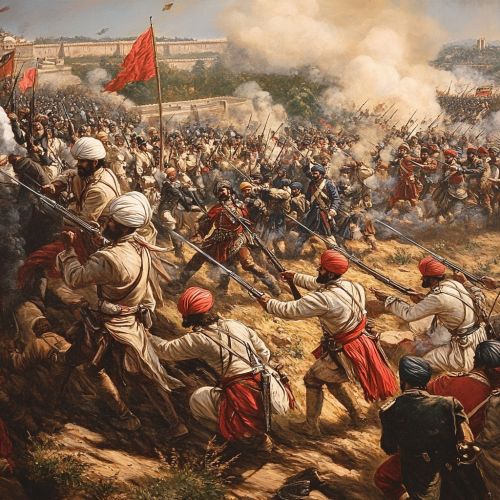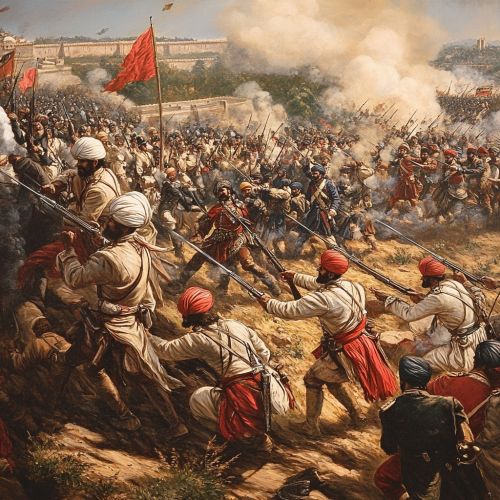Battle of Chillianwala: Difference between revisions
(Created page with "== Background == The Battle of Chillianwala was a significant military engagement fought on January 13, 1849, during the Second Anglo-Sikh War. This conflict took place in the Punjab region of India, near the village of Chillianwala, which is now part of modern-day Pakistan. The battle was characterized by fierce fighting and high casualties on both sides, making it one of the bloodiest encounters in the history of British India. == Prelude to the Battle == The Second...") |
No edit summary |
||
| Line 19: | Line 19: | ||
The battle commenced on the morning of January 13, 1849. The British forces advanced in three columns, with the intention of enveloping the Sikh positions. However, the dense jungle and uneven terrain disrupted their formations, leading to confusion and disarray. | The battle commenced on the morning of January 13, 1849. The British forces advanced in three columns, with the intention of enveloping the Sikh positions. However, the dense jungle and uneven terrain disrupted their formations, leading to confusion and disarray. | ||
[[Image:Detail-97631.jpg|thumb|center|Depiction of the Battle of Chillianwala with British and Sikh forces engaged in combat.|class=only_on_mobile]] | |||
[[Image:Detail-97632.jpg|thumb|center|Depiction of the Battle of Chillianwala with British and Sikh forces engaged in combat.|class=only_on_desktop]] | |||
The Sikh forces, entrenched in strong defensive positions, launched a series of counterattacks. The British infantry faced fierce resistance, and the cavalry charges were met with devastating volleys of musket fire. The Sikh artillery, strategically placed on elevated positions, inflicted heavy casualties on the advancing British troops. | The Sikh forces, entrenched in strong defensive positions, launched a series of counterattacks. The British infantry faced fierce resistance, and the cavalry charges were met with devastating volleys of musket fire. The Sikh artillery, strategically placed on elevated positions, inflicted heavy casualties on the advancing British troops. | ||
Latest revision as of 15:44, 17 August 2024
Background
The Battle of Chillianwala was a significant military engagement fought on January 13, 1849, during the Second Anglo-Sikh War. This conflict took place in the Punjab region of India, near the village of Chillianwala, which is now part of modern-day Pakistan. The battle was characterized by fierce fighting and high casualties on both sides, making it one of the bloodiest encounters in the history of British India.
Prelude to the Battle
The Second Anglo-Sikh War was precipitated by the British East India Company's desire to consolidate its control over the Punjab region following the First Anglo-Sikh War (1845-1846). The Treaty of Lahore, signed in 1846, had imposed harsh terms on the Sikh Empire, leading to widespread discontent among the Sikh populace and military. The death of Maharaja Ranjit Singh, the founder of the Sikh Empire, had also left a power vacuum that further destabilized the region.
In 1848, a rebellion broke out in Multan, leading to a full-scale uprising against British rule. The British responded by sending a large expeditionary force under the command of General Sir Hugh Gough. The Sikh forces, led by Sher Singh Attariwalla, were determined to resist the British advance and sought to exploit the difficult terrain and their knowledge of the local environment.
The Forces Involved
The British forces comprised approximately 12,000 troops, including infantry, cavalry, and artillery units. The army was well-equipped with modern weaponry and supported by a significant number of Indian sepoys. General Gough, an experienced commander, led the British forces with a strategy focused on aggressive assaults.
The Sikh army, numbering around 23,000, was composed of seasoned soldiers with a strong tradition of martial prowess. The Sikh forces were well-armed with a mix of traditional weapons and modern firearms. Sher Singh Attariwalla, a capable and charismatic leader, commanded the Sikh forces. The Sikhs also benefited from their familiarity with the local terrain, which they used to their advantage.
The Battle
The battle commenced on the morning of January 13, 1849. The British forces advanced in three columns, with the intention of enveloping the Sikh positions. However, the dense jungle and uneven terrain disrupted their formations, leading to confusion and disarray.


The Sikh forces, entrenched in strong defensive positions, launched a series of counterattacks. The British infantry faced fierce resistance, and the cavalry charges were met with devastating volleys of musket fire. The Sikh artillery, strategically placed on elevated positions, inflicted heavy casualties on the advancing British troops.
Despite the initial setbacks, General Gough ordered a series of frontal assaults, hoping to break the Sikh lines. These assaults resulted in brutal hand-to-hand combat, with both sides suffering significant losses. The British forces managed to capture some of the Sikh positions, but the cost was high.
As the battle raged on, the British forces struggled to maintain cohesion. The dense jungle and smoke from the gunfire further complicated communication and coordination. The Sikh forces, taking advantage of the confusion, launched several successful counterattacks, pushing the British back.
Aftermath
The Battle of Chillianwala ended inconclusively, with neither side able to claim a decisive victory. The British forces, having suffered heavy casualties, were forced to withdraw and regroup. The Sikh forces, although successful in repelling the British assaults, were unable to capitalize on their defensive success.
The battle had significant implications for both sides. For the British, it was a sobering reminder of the challenges posed by the Sikh military and the difficult terrain of the Punjab region. The high casualties and lack of a clear victory led to criticism of General Gough's leadership and tactics.
For the Sikhs, the battle demonstrated their resilience and ability to resist British advances. However, the lack of a decisive victory meant that the conflict would continue. The Second Anglo-Sikh War would eventually culminate in the Battle of Gujrat, where the British forces achieved a decisive victory, leading to the annexation of the Punjab into the British Empire.
Legacy
The Battle of Chillianwala is remembered as one of the most fiercely contested battles of the Second Anglo-Sikh War. It highlighted the formidable fighting capabilities of the Sikh army and the challenges faced by the British in their efforts to subdue the Punjab region. The battle also underscored the complexities of colonial warfare, where terrain, local knowledge, and the resolve of the indigenous forces played crucial roles.
The battle is commemorated in various historical accounts and has been the subject of military studies analyzing the tactics and strategies employed by both sides. It remains a significant event in the history of British India and the Sikh Empire, symbolizing the resistance against colonial expansion and the fierce determination of the Sikh warriors.
